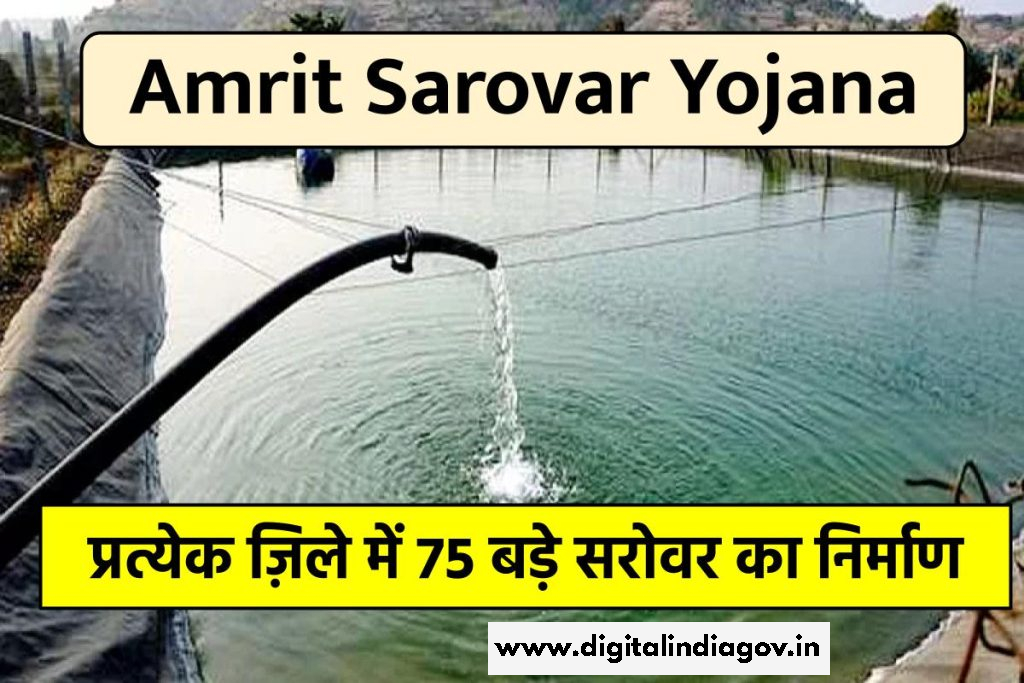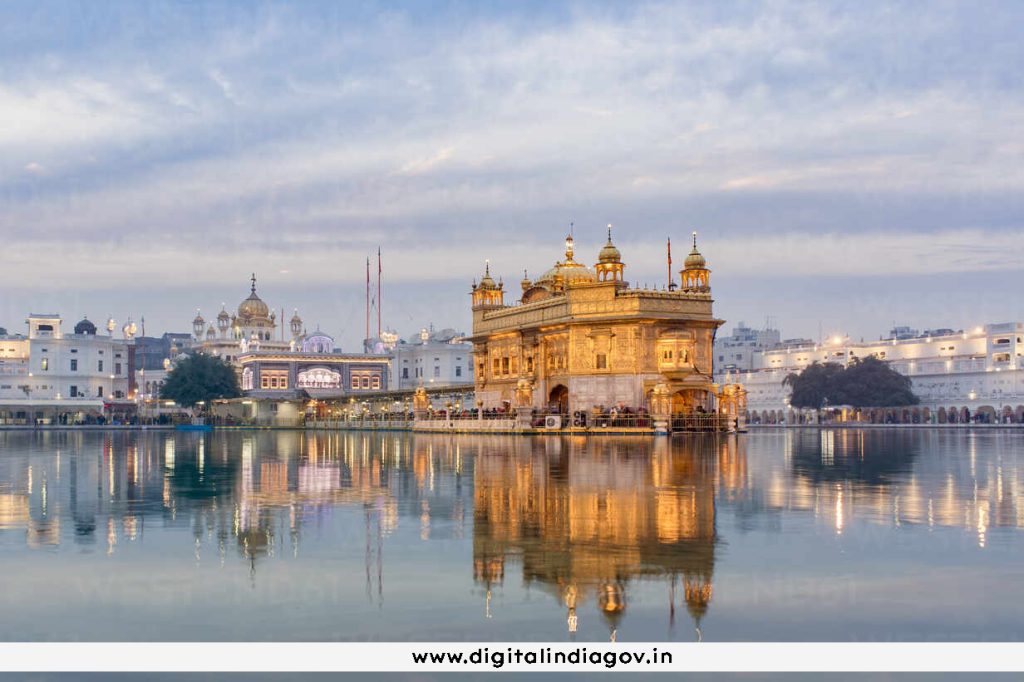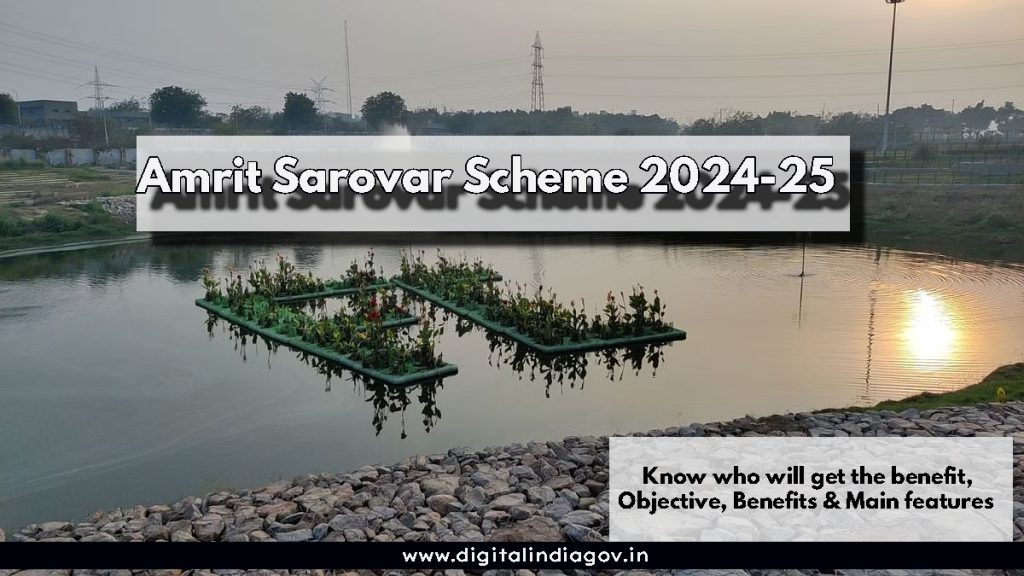Amrit Sarovar Scheme:- A gleaming strand interwoven with sustainability and progress is Mission Amrit Sarovar. With its April 24, 2022, opening as a part of India’s “Azadi Ka Amrit Mahotsav” celebrations honoring the country’s 75th anniversary of independence, Mission Amrit Sarovar has set out on a revolutionary mission to revitalize the water bodies that lie at the center of rural India.
Contents
What is the Mission Amrit Sarovar?
The ambitious goal of Mission Amrit Sarovar is to build or renovate at least 75 Amrit Sarovars in every Indian district. Numerous rural populations rely on these hallowed water basins, known as Amrit Sarovar, for nourishment, wealth, and hope. Combating the water crisis that has engulfed rural India and paving the road for water sustainability at the local level are the main goals of the mission.
Key points of Amrit Sarovar Scheme
| Name of the scheme | Amrit Sarovar Scheme |
| Objective | Underground water supply |
| Beneficiary | All districts of the country |
| Benefit | There will be relief from water shortage and farmers will be supplied with irrigation water. |
| Pond | To construct 75 Amrit Sarovar in each district |
| Official Website | amritsarovar.gov.in |

Also Read:- PM Shri Scheme
Amrit Sarovar Scheme Objective
The program’s objectives are to alleviate the nation’s water scarcity, supply farmers with water for irrigating their fields, and end the drought brought on by excessive heat. The government intends to construct 50,000 ponds by 2023 in order to address this. Each pond in the plan has a minimum surface size of one acre and can hold ten thousand cubic liters of water. In several parts of India, construction is underway to build ponds. The Government of India has also developed a portal to track the program’s implementation; you may access it from the comfort of your own home to learn everything there is to know about it.
Benefits of Mission Amrit Sarovar
- 10,000 cubic meters of water storage capacity will be available at Amrit Sarovar, which will be constructed on at least one acre of land. If the district is having trouble establishing a new Amrit Sarovar, it can choose to concentrate on revitalizing the structures that already exist in order to bring them back to their original ecological and productive roles.
- A special Gramme Sabha will approve the choice of Amrit Sarovar locations and appoint a Panchayat Partinidhi to manage Amrit Sarovar’s development on its behalf.
- The Mahatma Gandhi NREGS, XV Finance Commission Grants (tied and untied), PMKSY-WDC, PMKSY-HKKP-RRR, and other State or Federal Government programs are only a few of the sources of funding available to support this project. You can use these resources separately or together, depending on what you need to do to advance Amrit Sarovar.
Progress and Achievements
Mission Amrit Sarovar has made impressive progress towards its lofty objectives since its founding. Of the approximately one lakh Amrit Sarovars that have been located, about 81,000 have undergone medical treatment. The fact that over 66,000 Amrit Sarovars have been successfully constructed or renovated makes the achievement of the aim even more remarkable.
Reaching National Goals
A notable accomplishment of the mission was reaching the national goal of 50,000 Amrit Sarovars. This accomplishment is proof of the steadfast dedication of all concerned parties.
United in Purpose
Even though Mission Amrit Sarovar has had a great deal of success on a national level, it’s important to acknowledge the particular difficulties that each state faces. To reach the goal of 75 Amrit Sarovars per district, several states—West Bengal, Punjab, Telangana, Kerala, Tamil Nadu, Haryana, Bihar, and Rajasthan—are working hard. Their tenacity serves as a ray of hope, demonstrating the mission’s influence at the local level.
Utilizing Existing Schemes
Mission Amrit Sarovar mobilizes resources by utilizing financial grants and a variety of current programs. The success of the mission is largely due to initiatives like the Mahatma Gandhi National Rural Employment Guarantee Act, state-specific programs, and Pradhan Mantri Kisan Sampada Yojana sub-schemes. The mission can effectively handle the complex concerns of water sustainability by aligning these resources.
Community-Led Change
The focus placed by Mission Amrit Sarovar on citizen engagement and cooperation with non-governmental resources is one of its defining characteristics. Through the promotion of community involvement, the project leverages the combined strength of the local populace, guaranteeing the mission’s influence beyond its initial boundaries.
Unifying for a Common Cause
Fundamentally, Mission Amrit Sarovar is an example of a cooperative approach to attaining water security. The mission demonstrates the effectiveness of group action by bringing together local communities, technical partners, and government ministries. Its ultimate objective is not only to build Amrit Sarovars but also to improve livelihoods, change the water landscape, and guarantee water supplies for future generations.

Also Read:- Agneepath Scheme Apply
Target of Mission Amrit Sarovar
- The expected completion date for Mission Amrit Sarovar is August 15, 2023, with an objective of erecting an estimated 50,000 Amrit Sarovars nationwide.
- Amrit Sarovars are one acre in size and are intended to hold 10,000 cubic metres of water each.
- The mission places a great priority on the active engagement and involvement of the community.
- Interactions with local freedom fighters, Padma Awardees, residents of the area where an Amrit Sarovar is planned, and martyrs’ families will occur throughout the project.
- On August 15, national flag hoisting ceremonies will be held at each Amrit Sarovar location in honor of Independence Day, with the goal of further solidifying the community’s ties to the mission.
Ministries/Departments/Offices involved in the Amrit Sarovar Scheme
Following the launch of the Sarovar Yojana, the following six ministries and departments have begun work:
- Department of Land Resources
- Rural Development Department
- Ministry of Panchayati Raj
- Department of Water Resources
- Drinking Water and Sanitation Department
- Ministry of Forest, Environment and Climate Change
Main features of Amrit Sarovar Yojana
- The plan has resulted in the construction of 75 ponds in every state and district in the country.
- Agencies including the Ministry of Railways, Road Transport, and Highways, among others, are cooperating and participating in the pond excavation project as part of the Sarovar Yojana.
- growth of the area will follow the growth of the lake in rural areas.
- There will be peepal, banyan, and neem trees all around each lake.
- Plans will also be planned for the flag-raising ceremony at each Amrit Sarovar. The flag will be raised, for example, on Republic or Independence Day. We shall extend a warm welcome to the families of martyrs, freedom fighters, and Padma award winners.
- The pond will be filled with water to be used for a number of purposes, such as duck farming, fishing, irrigation, and water tourism, and it will generate revenue. In addition, Sarovar Pond will serve as a hub for social interaction in that vicinity.
- The pond honours the 75th Amrit Mahotsav of Independence.
Major states under the Amrit Sarovar Scheme
- Approximately 8,343 of the state of Uttar Pradesh’s 15,415 lakes have had work done on them.
- In Jammu and Kashmir, 1,383 of the 3,586 lakes have had their work finished.
- Only 589 of the 4,703 lakes in the state of Karnataka are complete.
- In the state of Himachal Pradesh, 615 out of 1,457 projects are complete.
- In Tamil Nadu, 799 of the 3,740 lakes have had work done on them.
- In the state of Rajasthan, 833 of the 5,050 lakes have had work done on them.
- Of the 5,974 lakes in the state of Madhya Pradesh, 1,564 have undergone completion.
- In the state of Bihar, 719 of the 3,374 lakes have had work done on them.
- Out of the 2,776 lakes in Gujarat state, 742 have had their construction finished.
- In the state of Maharashtra, 629 of the 3,469 lakes have had work done on them.

Also Read:- Mahila Samman Saving Scheme
FAQ’s
Q. Why is the name “Amrit Sarovar” significant?
Ans- The literal translation of “Amrit Sarovar” is “Pool of Nectar” in English. It represents the value of water as a resource for rebirth and sustenance.
Q. What role does Mission Amrit Sarovar play in the development of rural areas?
Ans- By guaranteeing access to sustainable and clean water sources, Mission Amrit Sarovar plays a critical role in rural development. This, in turn, promotes agricultural growth, health, and general well-being.
Q. What part does technology play in Sarovar’s Mission?
Ans– The utilization of technology, particularly geospatial data, and technologies that assist in locating viable places for Amrit Sarovar building and rejuvenation, makes the objective’s effective implementation possible.
Q. In what ways can the public help Mission Amrit Sarovar succeed?
Ans- By contributing to neighborhood projects, preserving water supplies, and raising knowledge of the mission’s goals and effects, citizens can take an active role in the process.
Suggested Link:- Our Jharkhand
@PAY
